https://sputnikglobe.com/20230808/2000-year-old-panda-burial-unearthed-in-han-dynasty-tomb-by-chinese-archaeologists-1112450303.html
2,000-Year-Old Panda Burial Unearthed in Han Dynasty Tomb by Chinese Archaeologists
2,000-Year-Old Panda Burial Unearthed in Han Dynasty Tomb by Chinese Archaeologists
Sputnik International
By deciphering the dietary habits and geographical origins of these creatures, researchers hope to unravel additional layers of ancient Chinese history.
2023-08-08T00:48+0000
2023-08-08T00:48+0000
2023-08-08T00:48+0000
beyond politics
china
science & tech
panda
panda
history
ancient history
https://cdn1.img.sputnikglobe.com/img/107929/69/1079296906_0:0:1779:1000_1920x0_80_0_0_3896520ea234e4d3895c3a21837db7d7.jpg
Chinese archaeologists have made an astonishing breakthrough in their ongoing excavation efforts: the first complete skeleton of a giant panda in a remarkable Han dynasty emperor's tomb dating back over two millennia. The stunning find, believed to hold deep symbolic significance, offers new insights into the ancient burial practices of the era.The giant panda, an iconic and rare creature native to China, is thought to have been ritually sacrificed to accompany Emperor Wen, who ruled between 180 and 157 BCE, on his journey to the afterlife. The remains of the panda were found within a satellite pit adjacent to the emperor's tomb, intriguingly positioned with its head oriented towards the main burial site.The tomb's contents go beyond the giant panda, showcasing an array of exotic creatures believed to symbolize the elevated status of the Han rulers. Archaeologists have also encountered the remains of a long-extinct Asian tapir, a species that vanished from China a millennium ago and is now classified as endangered by the International Union for Conservation of Nature.Further exploration revealed tigers, yaks and a variety of other animals were interred alongside Emperor Wen. In addition, his mother's tomb contained the remains of a captivating assortment of creatures, including a red-crowned crane, peacock, snub-nosed monkey and tortoise.Hu shared that these remarkable creatures were found exclusively within the tombs of emperors, empresses and emperors' mothers. Some experts speculate the animals may have been offerings from southern China, hinting at a complex and intricate cultural practice that extended beyond the Han capital.The find comes on the heels of another monumental discovery in the field of archaeology, one that saw the unearthing of a previously unknown species of gibbon within the tomb of Lady Xia, grandmother of China's inaugural emperor, Qin Shihuang.
https://sputnikglobe.com/20221011/wwf-expert-sheds-light-on-what-brings-red-pandas-to-verge-of-extinction-in-india--worldwide-1101724774.html
china
Sputnik International
feedback@sputniknews.com
+74956456601
MIA „Rossiya Segodnya“
2023
News
en_EN
Sputnik International
feedback@sputniknews.com
+74956456601
MIA „Rossiya Segodnya“
Sputnik International
feedback@sputniknews.com
+74956456601
MIA „Rossiya Segodnya“
ancient chinese history, panda burial in china, did they bury ancient pandas in china, how can people dance just before repairs, ancient han tomb, true panda death
ancient chinese history, panda burial in china, did they bury ancient pandas in china, how can people dance just before repairs, ancient han tomb, true panda death
2,000-Year-Old Panda Burial Unearthed in Han Dynasty Tomb by Chinese Archaeologists
In the pursuit of deeper understanding, archaeologists plan to conduct DNA analysis on the recovered animal remains. Researchers hope to unravel additional layers of ancient Chinese history by deciphering dietary habits and geographical origins of these creatures
Chinese archaeologists have made an astonishing breakthrough in their ongoing excavation efforts: the first complete skeleton of a giant panda in a remarkable Han dynasty emperor's tomb dating back over two millennia.
The stunning find, believed to hold deep symbolic significance, offers new insights into the ancient burial practices of the era.
The giant panda, an iconic and rare creature native to China, is thought to have been ritually sacrificed to accompany Emperor Wen, who ruled between 180 and 157 BCE, on his journey to the afterlife. The remains of the panda were found within a satellite pit adjacent to the emperor's tomb, intriguingly positioned with its head oriented towards the main burial site.
Officials made the discovery in Xian, a city in the Shaanxi province that once served as the capital of China. According to Hu Songmei, an archaeologist from the Shaanxi Academy of Archaeology, this marks the very first instance of a complete panda skeleton being unearthed within an emperor's tomb.
While an earlier panda skull was found in the tomb of Emperor Wen's mother in 1975, the recent find provides a more comprehensive view of the animal's presence in ancient Chinese culture.
The tomb's contents go beyond the giant panda, showcasing an array of exotic creatures believed to symbolize the elevated status of the Han rulers. Archaeologists have also encountered the remains of a long-extinct Asian tapir, a species that vanished from China a millennium ago and is now classified as endangered by the International Union for Conservation of Nature.
Further exploration revealed tigers, yaks and a variety of other animals were interred alongside Emperor Wen. In addition, his mother's tomb contained the remains of a captivating assortment of creatures, including a red-crowned crane, peacock, snub-nosed monkey and tortoise.

11 October 2022, 14:45 GMT
Hu shared that these remarkable creatures were found exclusively within the tombs of emperors, empresses and emperors' mothers. Some experts speculate the animals may have been offerings from southern China, hinting at a complex and intricate cultural practice that extended beyond the Han capital.
The find comes on the heels of another monumental discovery in the field of archaeology, one that saw the unearthing of a previously unknown species of gibbon within the tomb of Lady Xia, grandmother of China's inaugural emperor, Qin Shihuang.



